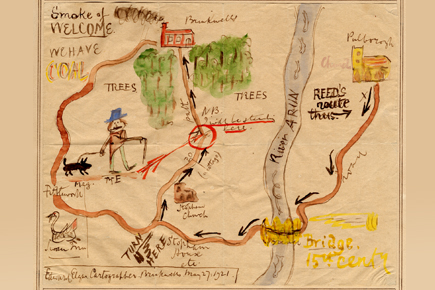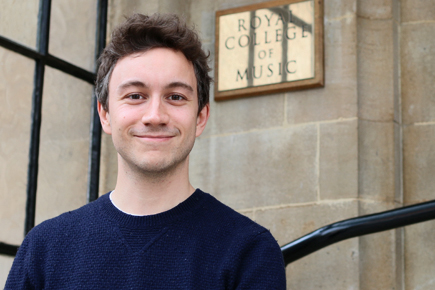Museum blog: Meet the Digitisation & Documentation Officer
Friday 26 May 2017
Name
Richard
Who
Digitisation & Documentation Officer
Favourite object(s) in the collection
My favourite item is the map Edward Elgar drew for his friend, William Henry Reed, directing him to his house in Sussex. Our collection is full of unique items, and this one in particular gives a different and more personal insight into the character of an important composer.

Do you have a musical background or play an instrument?
I started learning guitar from a young age, and still like to play regularly. Over the past few years I've been learning piano, so I've been enjoying the frustrations and fun of learning a new instrument all over again!
What are you up to today?
I'm working on MINIM-UK today, harvesting data about the British Museum's instrument collections, which involves working with lots of different types of data, researching their objects, and working to make the records available through the MINIM-UK database.
What will happen to that data?
It'll form a large section of the instrument records in the MINIM-UK resource, which will feature over 20,000 historical musical instruments from collections across the UK, and will launch to the publich in October 2017.
Can you tell us a bit about what you do in the Museum?
I'm responsible for digitising and documenting the collections, which involves bringing the information and data about our objects from lots of disparate sources and recording them in our collections management system, and digitising objects for archival and reproduction purposes. It also involves producing photography, videos and other digital media so that visitors can explore the collections while physical access isn't available. This work is particularly important now that our museum is closed for redevelopment, because it means people can still access and explore the collections online, and it ensures we have a useful, searchable resource for the long-term future.
What projects do you have going on right now?
I'm developing an online catalogue for our collection with an external supplier which is going to be launched soon. I'm also preparing for the next round of digitisation for our iconography collections, which will happen over the next two to three years. Thousands of photographs, engravings, and other iconography items which were transferred to Museum holdings need to be catalogued, so we’ll be recruiting volunteers to help work through the materials and prepare them for digitisation.
What's the best bit about your job?
You get to really delve in and find out about the collections, and directly engage with artefacts which are important to music history. And to get to share all of this with the outside world is a real privilege. Every day involves some sort of new discovery or direction!
What are the challenges?
I think the most challenging part is that documentation work theoretically never ends, as there's always new information to link to the collections, new connections to make, and more to find. Thankfully we have standards we work towards, so that we record the key information we need first. As our cataloguing work develops, and once everything has been recorded, we can develop connections and stories through research, and share them with the world.
Also, the world of digital cultural heritage is a rapidly evolving area, so it's increasingly important to consider aspects such as long-term digital preservation, and constantly explore new ways of presenting our collections through digital methods that might be beneficial to visitors and researchers. It can be quite a daunting prospect to keep up with all the latest developments, but the museum community is highly collaborative which is great for sharing ideas and experience.
Why are you important to the museum?
It's important that we have the tools to provide continual access to the collections within the College, and for our visitors. By developing and digitising our object information we can quickly access information about individual items, identify the themes that run through our collections, and present them to our audiences. The work undertaken now ensures the museum is prepared for the day-to-day management of our collections, and for the challenges of providing collections access both within the museum, and outside it.
Can you tell us a bit about the RCM collections in your own words?
The collections are a colourful window through which we can view the history of music in Britain, Europe, and around the world. We have instruments from accordions to zithers, and iconography relating to figures from Abel to Zemlinksy. Importantly, they allow us to experience music history, particularly with some of our historic instruments which are still playable. Our digital resources will allow people to hear them for themselves through specially commissioned recordings and videos, as well as enjoy them being demonstrated by performers when the Museum re-opens.
What are you most excited about for the future of the Museum?
The reopening! It's great to be part of the re-development and the Museum's new place in the College—I'm looking forward to our new activities, new displays, and how our digitisation programme will support all of these.
I'm also looking forward to working with our volunteers to survey the iconography collections. As we work through the archives, I look forward to new discoveries, and hopefully some surprises!
Lastly, if you could be a musical instrument what would you be and why?
A cor anglais, easy-going and relaxed!








